
Funk – By far the coolest of the cool

We all daydream. I know I do, and a recurring one for me always has two parts. The first it to be knighted by the Queen of England, even though I am not British, for my outstanding services to humanity—my founding of the Excellence in Indolence movement, for example, or my role as a legendary figure in the Lay-about/Idler community. The second part of that dream is, after having departed Buckingham Palace, to be interviewed on the BBC by a moderator of the intellectual stature of the late David Frost. Sounds snobby I know, but he really knew how to conduct an interview.
During this chat the moderator would ask, as the good ones nearly always do: “Sir Neal, tell us something that about yourself that we do not know.” Well, that “something,” is that I really like Funk music—especially that from the late 1960s and early 1970s although, as you will see, there are good examples from across the decades.
I’m not talking about modern hip-hop, rap, or the many sub-genres of those styles, although there are surprises there too, but the original Funk from the likes of Sly and the Family Stone, James Brown, and Rufus Thomas. Funk is downright fun, Funk has feeling, and Funk has the groove. If good Funk cannot get you moving, then I fear that you very well might already be dead!
Step back, if you will, with me to the early 1970s when I was in the 7th grade. The word started going around my middle school to tune into a Saturday afternoon television program that was setting a new standard for what was considered cool. For young people, of course, what is viewed as cool, and what is not, is life’s top priority. Sure, there are the usual movie stars, musicians, and athletes who set the norm for cool, but what I was seeing on TV was something completely new—something that was mesmerizing in its style and savoir faire. It was, and sometimes still is, the way that many of us wanted to be when we grew up.
What then was this phenomenon that was taking the young American viewership by storm? Well, it was Don Cornelius’ brilliant creation Soul Train—a dance program that he crafted, initially and primarily, with a musically interested African-American audience in mind, but one that soon became THE hot program to watch no matter what one’s race, color, or creed.
Don Cornelius was a DJ from Chicago who linked his hard work and business acumen with a love of music in order to bring together musicians with the young people who enjoyed dancing to their tunes. His creation, in the early 1970s, was a television show that was somewhat modeled on American Bandstand, but one that initially featured live performances instead of the musicians simply lip-synching.
Soul Train offered audiences the opportunity to see, hear, and dance to, the latest offerings from the inexhaustible wellspring of talented Black musicians—some of them, like James Brown, Curtis Mayfield, and Sly and the Family Stone were already famous, while others were up and coming. Scores of acts, including white ones such as Elton John, put in at least one, and often multiple, appearances on Soul Train. Just scanning through this list gives you a good idea of the talent Don featured: Artists who have appeared on Soul Train
Don himself was the absolute definition of cool. His smooth deep voice and calm demeanor bespoke an elegance that transcended any and all racial lines—he was, simply put, the one and only Don Cornelius. Take a glance at just the first two minutes of this clip (after the intro) to see Don’s style as he interviews James Brown, Bobby “Blue” Bland, and BB King Soul Train Interview and how he refers to James Brown’s band as his orchestra. Now how neat is that? With that single word Don reveals the coolness that he had running through his veins. You can also understand why every boy in my 7th grade class wanted to be like him and, as I said, most of us probably still do!
Yet the appearance of cool can only get you so far in life and in reality it was Don Cornelius’ keen ear and intuitions that made his program a success. He not only balanced new acts with the favorites from the broad canon of R&B, Soul, and Funk, but he also knew just how to package and deliver them to audiences across the country.
Thus, it was on Soul Train that I, an average white kid from the suburbs, heard Funk for the very first time. If it is true, that as we get older, the music we still like most is that which we listened to as teens, then it probably explains why I, and many others, have a lasting appreciation for Funk.
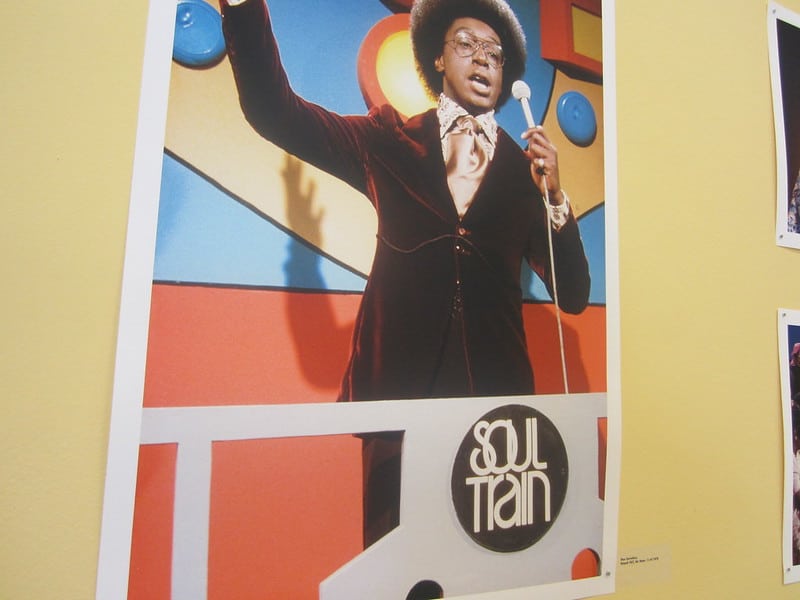
Don Cornelius
The word funk was used initially by musicians as a compliment to each other for having really sweated to make something sound good. Funk, back in the day, meant “earthy” and had the slang connotation of being “smelly” or “sweaty.” Thus, when a musician said something was funky, he meant that it had taken real effort and it’s not hard to imagine small clubs and jam sessions filled with artists pouring their all into creating music that had just the right groove and was therefore “danceable.”
While Funk certainly has deep roots in everything from gospel, jazz, Soul, and R&B, its trademark is the groove and feel. In Funk, the percussion and bass aren’t just static foundations, but instead are the jet fuel that propels the song forward. Funk also constantly draws on sources near and far, including elements of the West African percussive arts, to keep its beat fresh and moveable.
Funk brings the bass guitar out of the shadows and frequently gives it equal billing to the lead guitar or vocalist. In fact, it is not uncommon for the drums and/or the bass to take the lead—a sharp departure from the tradition of having the vocalist calling the shots with the lead guitarist, in the role of a trusty lieutenant, at his side. In Funk, the groove has the ultimate pride of place and it does not matter if it is, at any one time, being served up by a singer, a guitarist, or a percussionist.
As a gateway into Funk, I give you the Meter’s 1969 classic tune the Cissy Strut performed here by Gee Mack and his ensemble. Notice how Gee calls out at the beginning for his bandmates to give it a bit of that New Orleans flavor. While obviously not an exact musical term, he is asking the others, particularly the drummer, to swing the beat a bit to give it that distinct Funk feel—a feel that is like sex appeal in that you recognize it when you see it, or in this case, hear it. (See note 1 if you wish to hear Professor Rick Beato talk more about this feel.)
One of Funk’s most enjoyable aspects is how it seemingly idles along. In this remix of Rufus Thomas’ Breakdown, notice how the groove slowly hypnotizes you and takes you on an unhurried journey through the sonic landscape.
Now while there are scores of great Funk musicians that I could discuss, let me offer up three whose names might ring a bell: James Brown, Sly Stone, and Curtis Mayfield.
Naturally, any discussion of Funk wouldn’t be complete without the mention of James Brown. Known as the Godfather of Soul, Mr. Dynamite, Soul Brother #1, and the hardest working man in show business, James Brown was a musical force of nature renown for both his compositions as well as his athletic stage performances.
Brown was born into abject poverty in rural South Carolina in 1933. Not long afterward his family decamped to Augusta, Georgia, in search of better living conditions, but still found it a struggle to survive—so much so that the family even lived in an aunt’s brothel for a bit. He never gained much schooling and was left, for most of the time, to fend for himself.
While a stint in jail at age 16 could have been a serious setback, for James it proved to be a bit of a blessing in disguise—for it was there that he formed a Gospel Quartet and began to hone the voice and style that would become his trademark.
Yet his voice and charisma were not his only gifts as he displayed an incredible capacity for very hard work. We always credit successful people as “having worked hard,” but in Brown’s case he really did put his shoulder to the stone to become a soul singer and band leader of the first rank.
The small gigs he found in South Carolina and Georgia soon led to bigger venues and his shift to Soul and R&B opened up, by 1959, appearances at the famed Apollo theater in Harlem—a springboard to national, and then international, fame.
If you are not familiar with Brown, this 1966 recording of It’s a Man’s World gives you an idea of his vocal chops—quite something, isn’t it? Not long after this hit, he released what is considered to be one of the first true Funk songs Cold Sweat—a tune that was also the first in featuring a drum “break”—a quick solo that soon became a hallmark of Funk recordings. (You can here it in the Cold Sweat link starting about the 4 minute 50 second mark)
What I would like to draw your attention to, however, is his 1969 recording of the single Funky Drummer. Featuring Clyde Stubblefield on the drums, it remains one of the best examples of real Funk.
Notice the idle flow that I mentioned earlier. In this arrangement guitar, sax, and organ come and go as Brown does his trademark yipping and yelping—complete with his interjections of his famous “Good God.” Yet behind those vocal fireworks you hear his masterful work of using his voice as if it were a percussive instrument that, along with Stubblefield, keeps the beat.
Although Brown must have had an idea of what he wanted for this song before the tapes started rolling, one of the beauties of this recording is that he really doesn’t seem to know exactly where it is headed. He seems to surprise himself, after Stubblefield’s break, when he gives it the name Funky Drummer. That break, by the way, is one of the most sampled bits of music of all time.
Give It Up or Turnit A Loose (no sic) and Ain’t It Funky are just two more of so many possible examples that display Brown’s inimitable style in finding, and sustaining, a downright enjoyable groove.
Brown’s full career and song catalog is far too long to detail here as he continued to perform even in his early seventies—as we see is this example from the 2004 Glastonbury music festival.
He certainly had his ups and downs in life. He again served time in prison in the late 1980’s, was repeatedly arrested for domestic violence, and had numerous brushes with drugs and the law. I mention these struggles not to dwell on any weakness, but rather to emphasize that even those to whom the gods of creativity have so amply entrusted with talent, are still humans and face the challenges of life just like the rest of us.
Yet Brown was equally as quick to donate abundantly to a number of good causes—something he actually did and was not just an act of public relations. His hometown of Augusta remembers him fondly for his generosity and has honored him in many ways.
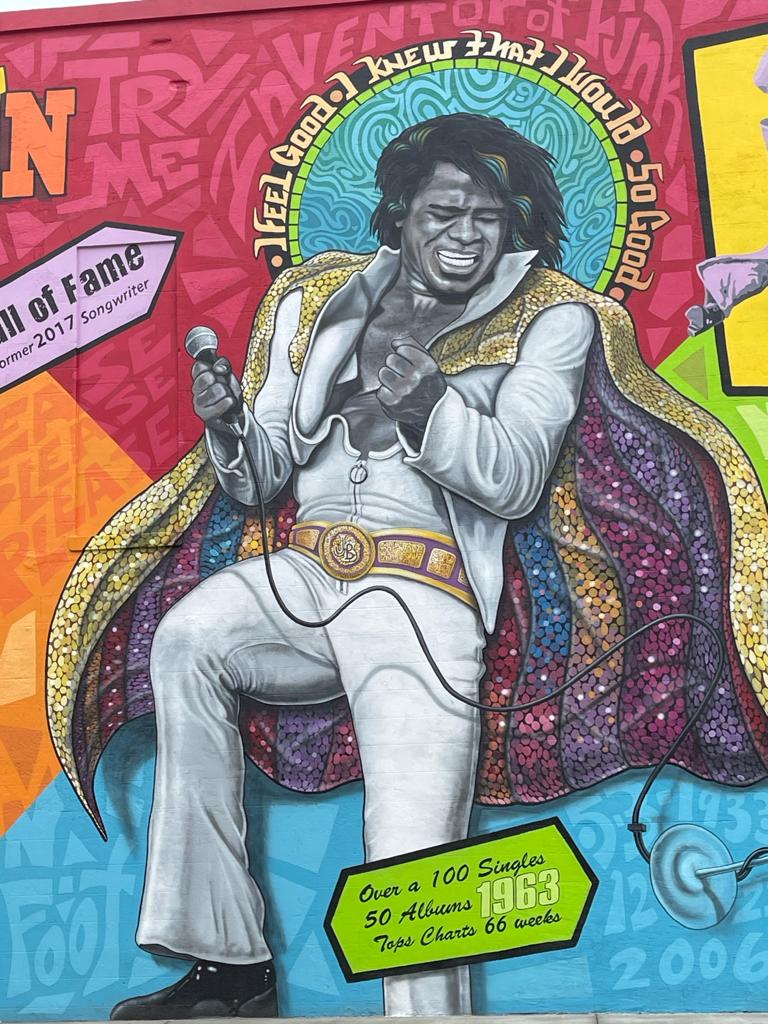
A good friend of mine, a physician from the area, proudly displays in his office an autograph from James that says “Stay in school.” It was this type of encouragement to young people that achieved more results that we can imagine.
A second master of Funk is Sly Stone who, along with his eponymously named ensemble Sly and the Family Stone, found his start in the mid-1960s in the Oakland and Bay Area music scene. After a lackluster beginning, he and his band hit their stride with hits such as Everyday People and Dance To The Music, but it was his arrangement Thank You (Thank You Falettinme Be Mice Elf Agin seen here on Soul Train) (no sic!) that reveals the group’s chops with Funk. They approach the groove a bit differently, but certainly as effectively, as James Brown and the others.
While I have discussed the strong beat of Funk and its danceability, Stone’s Family Affair, a much more lyrical arrangement, shows that Funk maintains that special feel even when done slowly. Yes, that is a drum machine you are hearing, but it takes a back seat as Stone uses the organ and his voice to give the song its special sauce. Pleasantly funky, isn’t it?
Sly Stone was, from his earliest years, a child prodigy. His talents were such that he could pick up an instrument and quickly be proficient. Thus, it was of no surprise that he set off on a musical career and, when he did, he was among the first to have both a racially and male/female integrated band. This was something that drew severe criticism from many sides in the socially charged atmosphere of the time but he, admirably, shrugged off these barbs and hired the musicians he wanted.
Sly not only created and performed music, but he also influenced countless musicians of the succeeding generations—just look at Prince to hear and see the musical DNA that was, figuratively, passed down.
Stone’s story, however, is rather sad. He was ravaged by drug use and was infamous in the following decades for, either outright cancelling concerts, or sometimes not being able to play even if he and his bandmates did show up. There is no doubt that he was engaged in some epic personal struggles to keep afloat, but when he did take to the stage the audiences loved him.
Yet…there always remained flashes of his brilliance. Although not in finest of fettle physically, you can skip around this long clip (I suggest 6:30) from a festival in Tokyo in 2006 to hear the voice that earned him a place among the greats: Sly in Tokyo
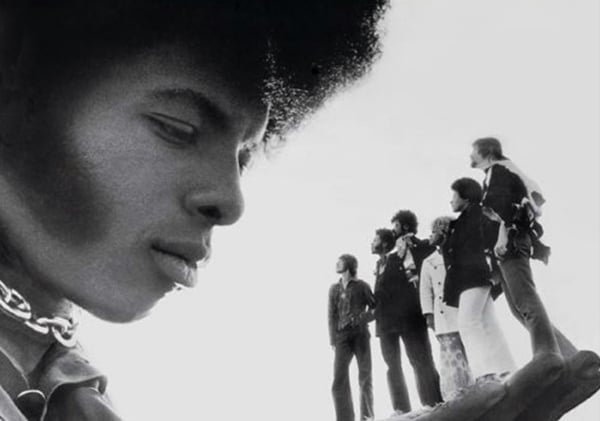
Sly the Family Stone
If I could bring any of those aforementioned greats back to life for just an hour interview, my choice would be the 3rd member of my Funk Troika—Mr. Curtis Mayfield. Curtis took a slightly softer approach to Funk and coupled it with a deep thoughtfulness in discussing social challenges such as drug use, equality, and poverty. In fact, Brown, Mayfield, and Stone, each in their own way, articulated remarkably prescient and positive social views—something I can touch on in another article should anyone wish.
Curtis Mayfield was born in 1942 and spent his early and teen years in the rough projects of Chicago. He ended his education prematurely and instead dedicated himself to both writing and performing music. He found a start in that seedbed from which so many great musicians sprung—Gospel. He taught himself the guitar to add to his skills on the piano, but was most keen on writing lyrics—and not just the “I love you and you love me” kind of thing, but rather lyrics with real meat on the bones.
In fact, Mayfield either wrote, or co-wrote, a number of the anthems of the Civil Rights movement—including what is considered to be THE song of that movement: People Get Ready.
Mayfield went on to write the soundtrack to the movie Superfly and here I offer you the title track to that album: Superfly. This is a softer, almost understated, style of Funk, but one that nevertheless has a great groove.
Yet the song I like most from Mayfield is another from the Superfly album and that is Pusherman in which he speaks of the dangers of someone pushing drugs in the neighborhood. Notice how he never gets loud with the beat, never overdoes any of the instrumentation, never pushes it too fast, and yet the song retains that good old-fashioned Funk feel by the way of some seriously good percussion.
Mayfield continued on with that exploration of the dangers of street life in the Superfly album with another classic: Freddie’s Dead. Here is a quick interview with him and Don Cornelius from 1973 in which you get an idea of the man behind those lyrics and the issues he was writing about: Mayfield interview
Curtis was unfortunately paralyzed from the neck down in a stage accident in 1990 and passed away all too early in 1999. The world is poorer without him, but we can take consolation from fine works of those artists, even all the way to the modern era of Bruno Mars, who have, and hopefully will continue to, follow both his style and his ethos.

The one and only Curtis Mayfield
There are, of course, many other Funk greats. Artists like Isaac Hayes and his theme song for Shaft with the immediately recognizable guitar sound. If you were at school in the early 1980s you might remember Rick James’ Super Freak. Although I was never a fan of their offerings, the Ohio Players and Earth, Wind, and Fire might be something that you enjoy. George Clinton, along with bassist Bootsy Collins, served up edgier funk tunes in his P-Funk ensembles (see Note 2) with tunes such as We Got The Funk and Atomic Dog.
Some songs crossed many lines. Remember War by Edwin Starr or Vehicle by the Ides of March and its 19 year old Chicago suburbanite lead singer Jim Peternik.
And who can overlook that incredible mashing of old movie stars dancing along to Mark Ronson and Bruno Mar’s Uptown Funk. Seriously, this one is REALLY worth watching to see how someone matched the beat with the visuals of dance—Just look at the overlay of music and scene at the 1:35 to 1:41 to see the brilliance.
I will leave you with the good news Funk lives on. The British actor Craig Charles presents a Funk and Soul show on BBC Radio in which he features both the oldies and some surprising new acts. I provide links of his show in Note 3, but if I might offer up a recent arrangement that pays homage to those early days of Funk. Shaka Loves You, a young Scottish duo (seriously, here they are if you don’t believe me: https://shakalovesyou.com/ ) linked up with the singer Fullee Love (aka Soup of Jurassic 5) to produce Boogie.
If you have skipped past the list of all the links in the video that is ok—except now. Boogie is guaranteed to get you moving—just watch the example of the Scottish kids tucking into it. See? Funk can be every bit as good as it was back when it first started.
As I was researching this article, I ran across a comment that called Funk a “bunch of schlock” and one should instead solely listen to the jazz greats such as Mile Davis and Charlie Parker. Well, everyone has his/her opinion, but when you are driving along and feel so good that you just want to let go then you will discover that Funk is not schlock at all but pure fun and the coolest of the cool—so crank it up!
Please let me know in the comments what you think as I look forward to your thoughts. As we part, I am reminded how Don Cornelius would often end a Soul Train episode with a call for Peace, Love, and Soul!
![]()
- Professor Rick Beato, an eminence grise of sorts among YouTube musical explainers, talks about how quantizing the drums on a Jonas Brothers track takes away the Funk feel. He is not at all slagging off the Jonas Brothers, but rather is criticizing a New York Times reviewer’s opinion that this track is representative of a true Funk feel/beat. Why “Sucker” is not Funk
- P-Funk stands for a music collective that arose from, primarily, two bands. Parliament and Funkadelic. Through the years it has been headed by George Clinton and has fleets of musicians that tuck in and out of various recordings and performances. Part surrealistic art and part music, starting in the 1960’s these musicians have influenced Funk, hip-hop, and other similar genres. P-Funk
- The BBC has an incredible offering of music for any taste and I would encourage you to take a few minutes to see just how mind-boggling it is just to scroll through their site and see the program offerings BBC Music. They have everything from classical to rap and from country to International sounds. Craig Charles is part of BBC’s strong stable of hosts and he presents a Funk and Soul program that can be found here: Charles Funk show. There are also any number of young English DJs that you can find on YouTube who either make mixes of his program or the music offered on it. You might see these efforts listed on YouTube as Craig Charles and the Trunk of Funk such as here: DJ Funk and Remix Funk — Fun stuff!

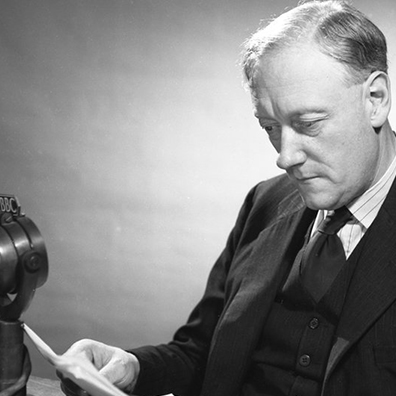
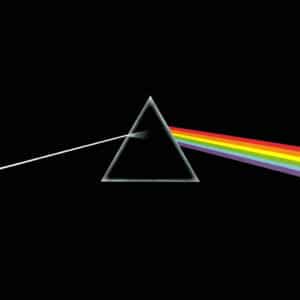
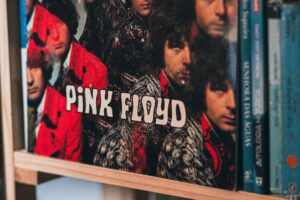



Awesome article Neal. I do like Earth, Wind and Fire. Those horns!
Thanks Mark! EW&F did indeed have a great horn section. Some real talent there.
Thanks for this article, Neal. I had the honor of meeting James Brown a few times over the years. It was around 1971 when I got the autograph w “Stay in School” in the margin. One thing I doubt people from outside the Augusta area know is that James loved Christmas, and had a HUGE display in his front yard every year. There were always cars lined up and down Walton Way extension, and most times the gate was open and you could wander around his display area. It was during one of these forays that James came out of his house and did a meet and greet. Great talent, great guy!
Thank you Phil and what a honor indeed to have met him. That is SERIOUSLY cool that James always went home to Augusta instead of just bolting to some LA rich and famous enclave.
BTW, isn’t that clip great where Don Cornelius is interviewing him and James is just awestruck by being in the presence of Bobby Bland and BB King! Talk about a trio of greats!
Great piece Neal – one that I’m sure was difficult to distill into one article!
I truly loved the understated presentation of Mayfield. Poignant lyrics, subtle intonations, and always the underlying funk, as you indicate carrying the music along. One can imagine never running out of gas in the funk powered vehicle.
I attended a concert by Average White Band in the mid 70s. Attended by roughly equal numbers of black and white fans, the distinction was made clear by the clothes. Crushed velvet ensembles of hats, calf-length jackets, frilled tuxedo shirts, and platform shoes ensured the competition for best dressed was never in doubt. Great memories.
I know the topic is funk, but I gotta pity you for your inability to be able to ride the miracle that was Maurice White and Earth, Wind, and Fire!
Thanks for the article. You do this well!
Thank you Fitz for the most kind words and, as always, for the time you take to read these long (and getting longer!) missives.
I appreciate that you, as well, are somehow struck by Mayfield. Understated is the perfect word to describe his approach and yet it adds such depth to his music. You can see why he would make an interesting interlocutor to sit next to on a long flight and to chat about his lyrics and style.
Enjoyed the Uptown Funk vid! Very light hearted
I really enjoyed it, Neal. I agree with your assertion that the bass takes the lead in a funk song. I find that aspect very interesting because in many genres, you barely notice the bass. The funkiest song I have in my current playlist is Jungle Boogie by Kool and the Gang, a definite childhood favorite and work of art.